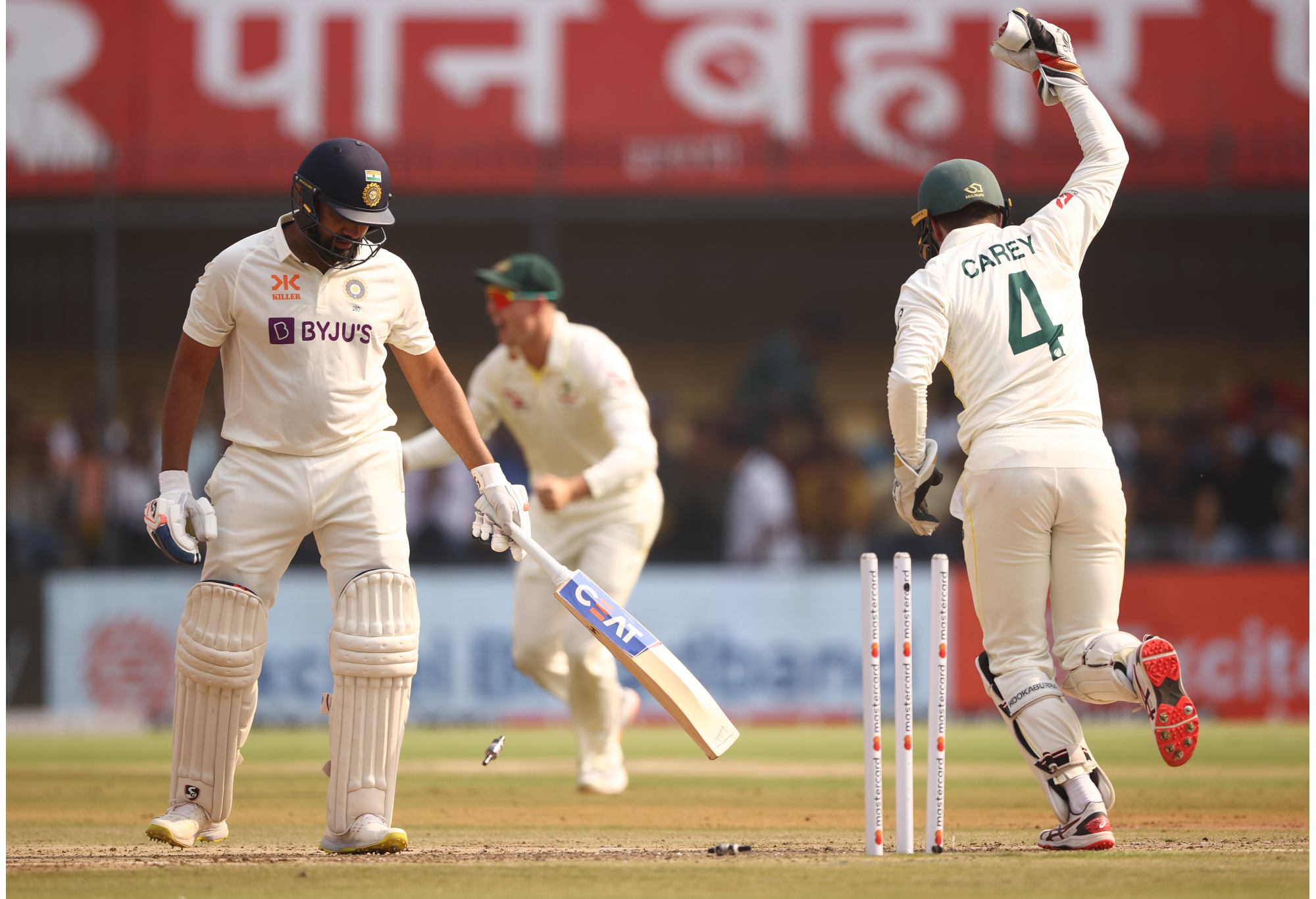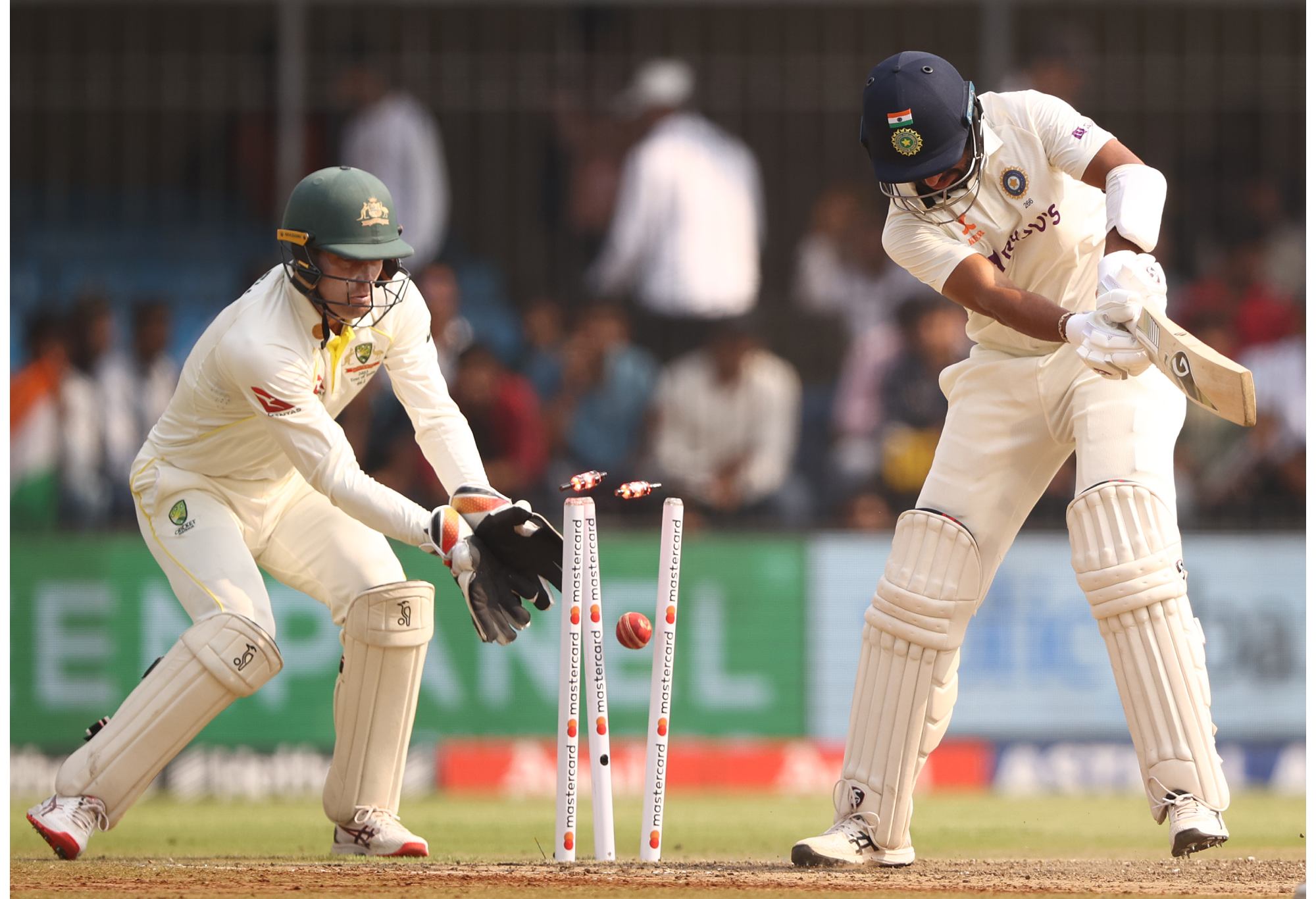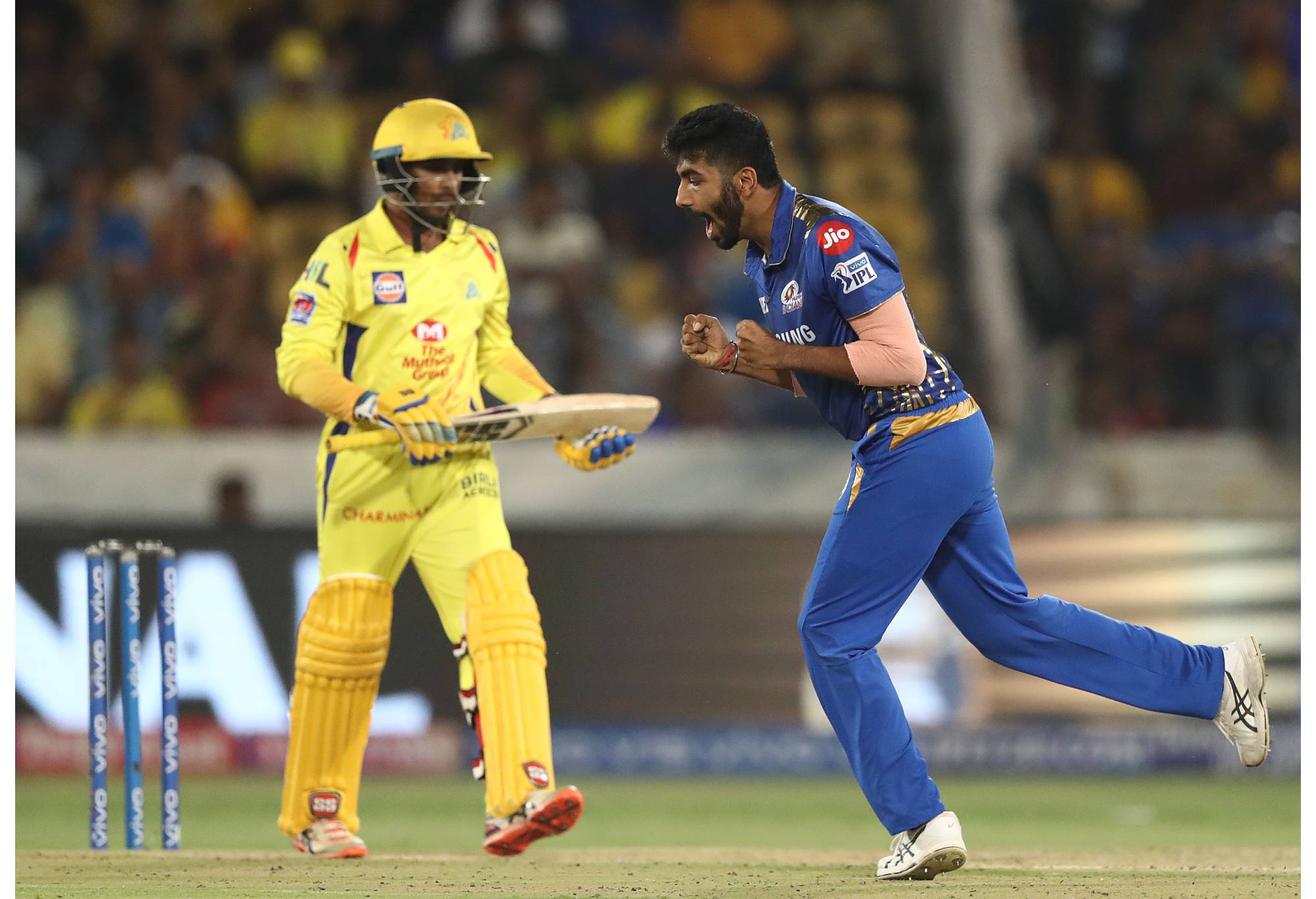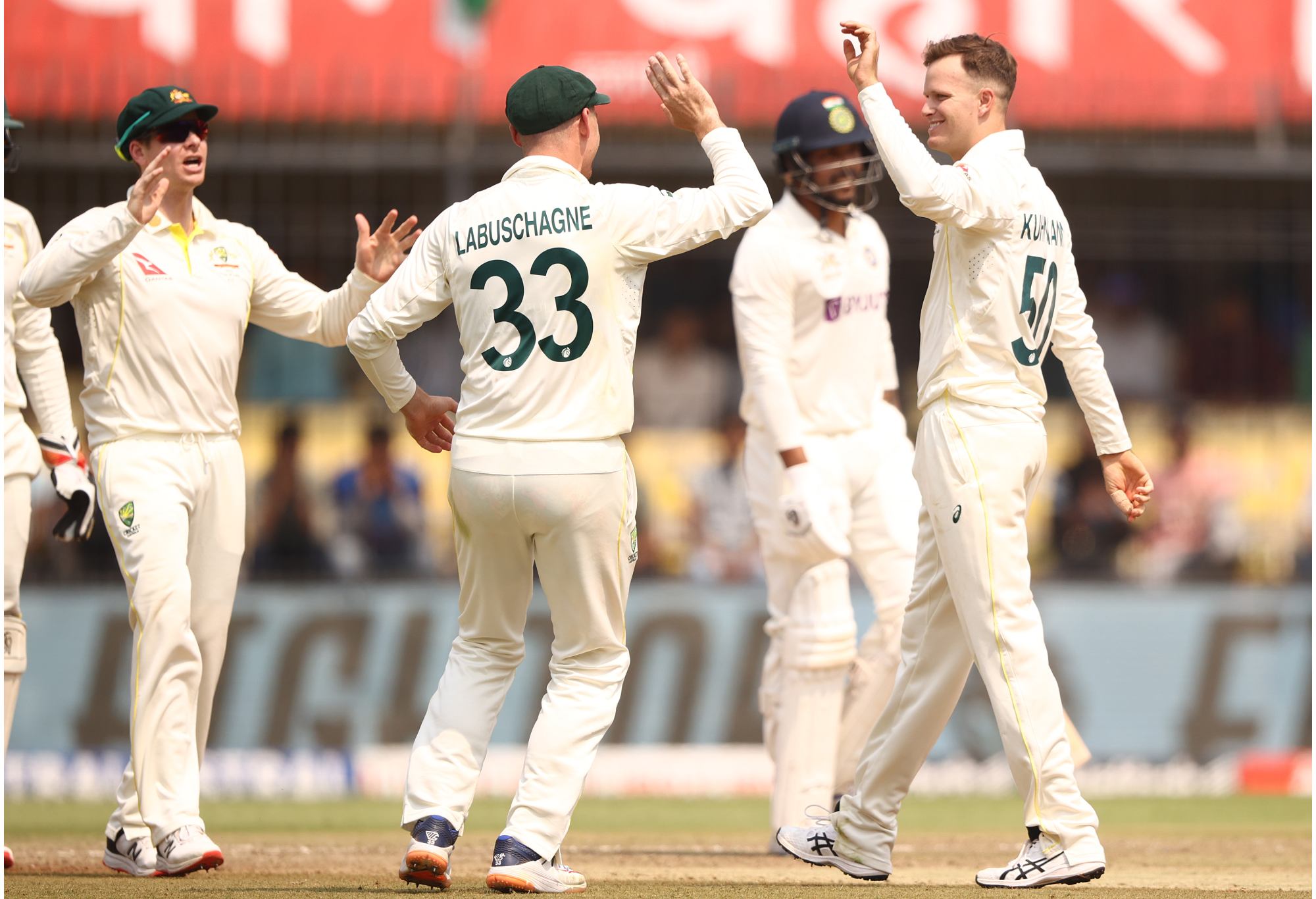In the grand scheme of things it doesn’t really matter that the ICC has backtracked on its “poor” rating for the third Test in India.
For anyone who has been wearing blinkers for the past two decades, it will come as a shock that the Board of Control for Cricket in India has stomped its feet, thrown a tantrum and yet again got its own way after being slapped on the wrists.
The last two words of the BCCI’s full title are becoming redundant if they aren’t already – India controls cricket, full stop.
The pitch at Indore’s Holkar Stadium was initially rated poor by match referee Chris Broad, and rightly so. It was not up to Test standard and just made it into a seventh session early on day three.

Rohit Sharma is stumped by Alex Carey at Indore. (Photo by Robert Cianflone/Getty Images)
After the BCCI launched an appeal, surprise, surprise, the sharply turning wicket has been revised to “below average” which still doesn’t mean much.
An ICC panel reviewed footage of the match (a task made easier by the face that nearly three days of play went to waste) and announced there was an insufficient amount of “excessive variable bounce” for the pitch to be poor.
And all that means is Indore cops one demerit point instead of three – a venue needs to receive five in as many years to warrant a one-year suspension.
As if India care about that – they have that many grounds to choose from already.
How many venues do you think have hosted internationals in India this century alone?
Higher, you’re not even in the right ballpark.
There’s that many ballparks.
Guess again.
Higher.
Thirty-nine.
Indore’s stadium has been used just 12 times for the 400 international fixtures in India since the turn of the century.
The other three pitches from the Border-Gavaskar Trophy series were rated average – that last one in Ahmedabad should also have been deemed poor.
Broad thought the Indore contest was not a fair one between bat and ball as the spinners ran riot, the opposite was the case in the final Test when just 20 wickets over five days of tedium.
It’s almost like the BCCI decided they wanted a draw to ensure Australia didn’t level the series and that should be enough to get them through to the World Test Championship final because Sri Lanka were unlikely to win both Tests in New Zealand.
But that would be pitch doctoring. And they don’t do that in India. Well, that’s what the BCCI official line is and any peaon who questions their authority will be flattened by their heavy roller.

Cheteshwar Pujara is bowled by Nathan Lyon at Indore. (Photo by Robert Cianflone/Getty Images)
What this Indore protest was about was simply the BCCI flexing its collective muscle to say because we bring in the vast majority of global revenue for the sport, we run cricket and there’s nothing anyone can do about it.
And with the IPL only getting bigger and taking up more space on the calendar, the Indian empire is only going to expand at the expense of international fixtures.
The recent launch of the Major League Cricket start-up in the US is another step towards the T20 leagues not necessarily taking over the calendar but further reducing the scope for the game’s best players to represent their countries in traditional international fixtures.
Just like they’ve done with the new South African T20 competition, IPL franchises have invested in the US league to extend their global reach and create a farm system.
CLICK HERE for a seven-day free trial to watch cricket on KAYO
A goliath like the Mumbai Indians is following the model of the City Football Group who have Manchester City in the English Premier League as their flagship with outposts in New York, Melbourne, Japan, Uruguay, Spain, China, Belgium, France, Bolivia and even India.
Mumbai’s owner Reliance Industries in the past year has added offshoots in Cape Town, New York and Abu Dhabi in the UAE league who all wear their blue and gold colours.
With all the talk about Cricket Australia potentially opening the door for private ownership in the BBL, there is a strong chance a current franchise could end up part of an IPL behemoth.

Jasprit Bumrah celebrates a wicket for the Mumbai Indians against Chennai Super Kings. (Photo by Robert Cianflone/Getty Images)
The eight Australian teams are well established so it’s unlikely they’ll change names and colours like Melbourne Heart did when they became Melbourne City in the A-League but the extra foreign capital could help the BBL in the global battle for talent.
More money for a shorter season is on offer at South Africa and the UAE at the moment, which is why the likes of Chris Lynn, Rashid Khan, Colin Munro, Trent Boult and Alex Hales jetted across the Indian Ocean midway through the BBL.
With IPL franchises having ports of call dotted around the globe, it won’t be long before they sign elite players on annual contracts.
The player could then represent the team in the IPL and then maintain their form, earn huge dollars and travel the globe throughout the rest of the year at the franchise’s various feeder sides.
They would earn way more than the central contracts that all Test-playing nations can offer their players to line up for international duty.

Matthew Kuhnemann celebrates taking the wicket of Umesh Yadav. to give him 5-16 in the third Test. (Photo by Robert Cianflone/Getty Images)
Under this scenario it would be similar to football where the player can turn out for the international matches that sit in spare windows in the calendar and the franchise would release them to their home nation, not the other way around.
The main factor holding back this seemingly inevitable situation at the moment is the prestige of international cricket, the value placed on global tournaments like the T20 and ODI World Cup and the World Test Championship.
Rolling out poor pitches and then not being accountable for it may not seem like a major cog in the wheel in the grand scheme of things but it’s another example of cricket not giving its diehard fans due respect.
One shortchanged the supporters by providing an uneven, albeit must-see, contest for a little more than two days. The other turned what could have been an important final Test into a snoozefest.
Both the third and fourth Tests were poor whichever way you look at them and those kinds of pitches need to be eradicated in international cricket or the T20 leagues have already won, if they haven’t already.
































































































